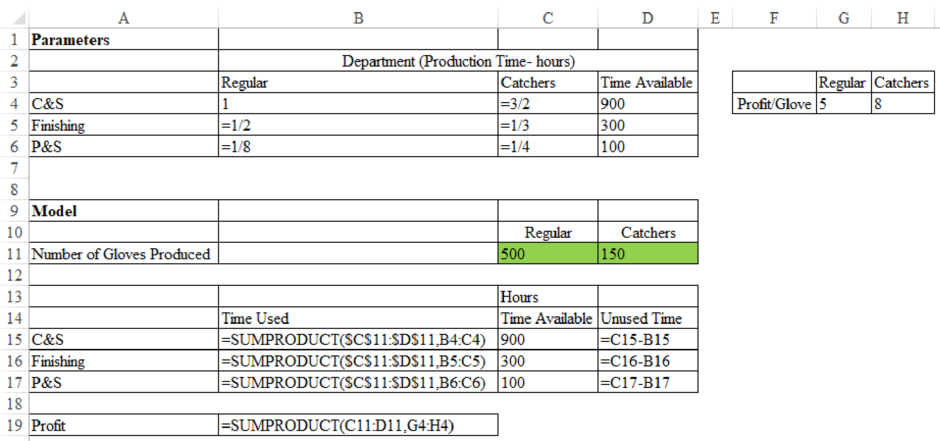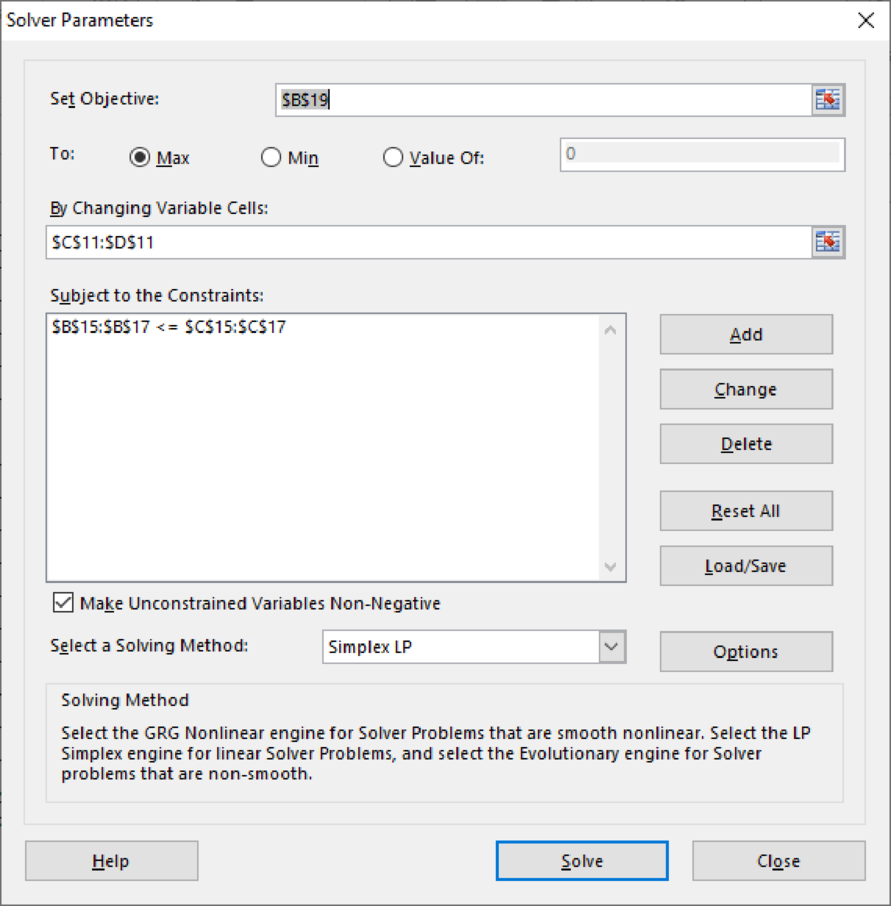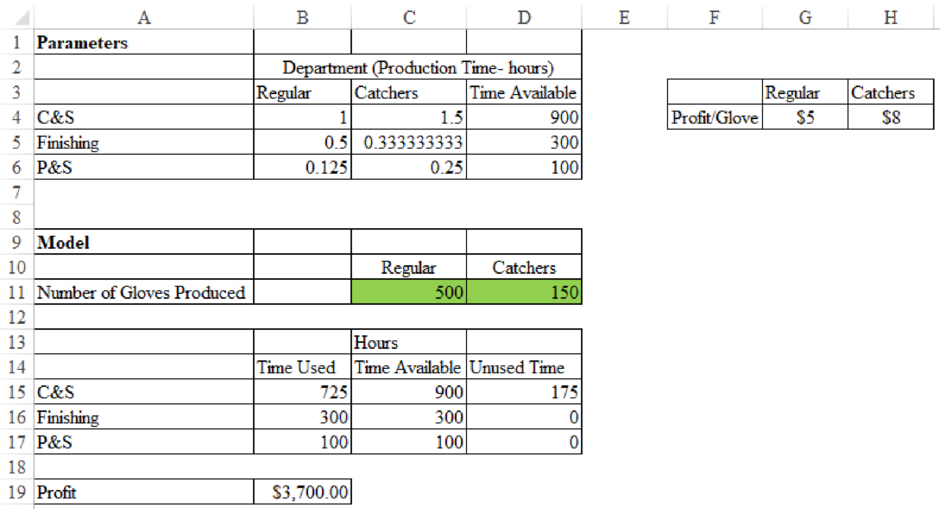
Kelson Sporting Equipment, Inc., makes two types of baseball gloves: a regular model and a catcher’s model. The firm has 900 hours of production time available in its cutting and sewing department, 300 hours available in its finishing department, and 100 hours available in its packaging and shipping department. The production time requirements and the profit contribution per glove are given in the following table:

Assuming that the company is interested in maximizing the total profit contribution, answer the following:
- a. What is the linear programming model for this problem?
- b. Develop a spreadsheet model and find the optimal solution using Excel Solver. How many of each model should Kelson manufacture?
- c. What is the total profit contribution Kelson can earn with the optimal production quantities?
- d. How many hours of production time will be scheduled in each department?
- e. What is the slack time in each department?
a.
To form the linear programming model for the given problem.
Explanation of Solution
Through linear programming, the best outcome is achieved by using a mathematical model. The model in this case is shown below:
Let,
Max
s.t.
b.
The spreadsheet model, optimal solution, and number of units of each model manufactured by person K.
Explanation of Solution
On solving the above formulation in excel spreadsheet using solver,
Formula:

Solver:

Output:

The optimal solution will be to produce 500 regular gloves and 150 catchers.
The profit in this case will be $3,700.
c)
To find the total profit contribution earned by person K by producing optimal quantities.
Explanation of Solution
Total profit that person K can earn by producing optimal quantities will be:
The optimal solution to produce regular gloves and catchers is substituted in the objective solution, then the profit obtained is,
The profit is $3,700
d.
To find the production time to be scheduled in each department.
Explanation of Solution
The production time for every department can be calculated as follows:
For C&F
For F
For P&S
e.
To find the Slack time in each department.
Explanation of Solution
The slack time for each department is calculated by subtracting capacity of the department with the total usage.

The slack time in hours for every department is shown in the above table.
Want to see more full solutions like this?
Chapter 8 Solutions
Essentials Of Business Analytics
- please find the answers for the yellows boxes using the information and the picture belowarrow_forwardA marketing agency wants to determine whether different advertising platforms generate significantly different levels of customer engagement. The agency measures the average number of daily clicks on ads for three platforms: Social Media, Search Engines, and Email Campaigns. The agency collects data on daily clicks for each platform over a 10-day period and wants to test whether there is a statistically significant difference in the mean number of daily clicks among these platforms. Conduct ANOVA test. You can provide your answer by inserting a text box and the answer must include: also please provide a step by on getting the answers in excel Null hypothesis, Alternative hypothesis, Show answer (output table/summary table), and Conclusion based on the P value.arrow_forwardA company found that the daily sales revenue of its flagship product follows a normal distribution with a mean of $4500 and a standard deviation of $450. The company defines a "high-sales day" that is, any day with sales exceeding $4800. please provide a step by step on how to get the answers Q: What percentage of days can the company expect to have "high-sales days" or sales greater than $4800? Q: What is the sales revenue threshold for the bottom 10% of days? (please note that 10% refers to the probability/area under bell curve towards the lower tail of bell curve) Provide answers in the yellow cellsarrow_forward
- Business Discussarrow_forwardThe following data represent total ventilation measured in liters of air per minute per square meter of body area for two independent (and randomly chosen) samples. Analyze these data using the appropriate non-parametric hypothesis testarrow_forwardeach column represents before & after measurements on the same individual. Analyze with the appropriate non-parametric hypothesis test for a paired design.arrow_forward
 MATLAB: An Introduction with ApplicationsStatisticsISBN:9781119256830Author:Amos GilatPublisher:John Wiley & Sons Inc
MATLAB: An Introduction with ApplicationsStatisticsISBN:9781119256830Author:Amos GilatPublisher:John Wiley & Sons Inc Probability and Statistics for Engineering and th...StatisticsISBN:9781305251809Author:Jay L. DevorePublisher:Cengage Learning
Probability and Statistics for Engineering and th...StatisticsISBN:9781305251809Author:Jay L. DevorePublisher:Cengage Learning Statistics for The Behavioral Sciences (MindTap C...StatisticsISBN:9781305504912Author:Frederick J Gravetter, Larry B. WallnauPublisher:Cengage Learning
Statistics for The Behavioral Sciences (MindTap C...StatisticsISBN:9781305504912Author:Frederick J Gravetter, Larry B. WallnauPublisher:Cengage Learning Elementary Statistics: Picturing the World (7th E...StatisticsISBN:9780134683416Author:Ron Larson, Betsy FarberPublisher:PEARSON
Elementary Statistics: Picturing the World (7th E...StatisticsISBN:9780134683416Author:Ron Larson, Betsy FarberPublisher:PEARSON The Basic Practice of StatisticsStatisticsISBN:9781319042578Author:David S. Moore, William I. Notz, Michael A. FlignerPublisher:W. H. Freeman
The Basic Practice of StatisticsStatisticsISBN:9781319042578Author:David S. Moore, William I. Notz, Michael A. FlignerPublisher:W. H. Freeman Introduction to the Practice of StatisticsStatisticsISBN:9781319013387Author:David S. Moore, George P. McCabe, Bruce A. CraigPublisher:W. H. Freeman
Introduction to the Practice of StatisticsStatisticsISBN:9781319013387Author:David S. Moore, George P. McCabe, Bruce A. CraigPublisher:W. H. Freeman





